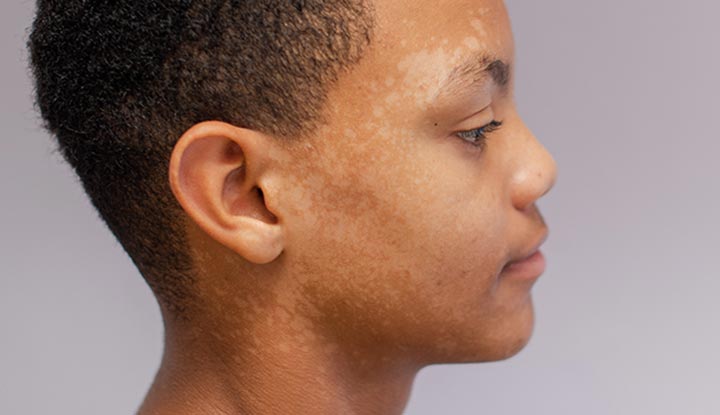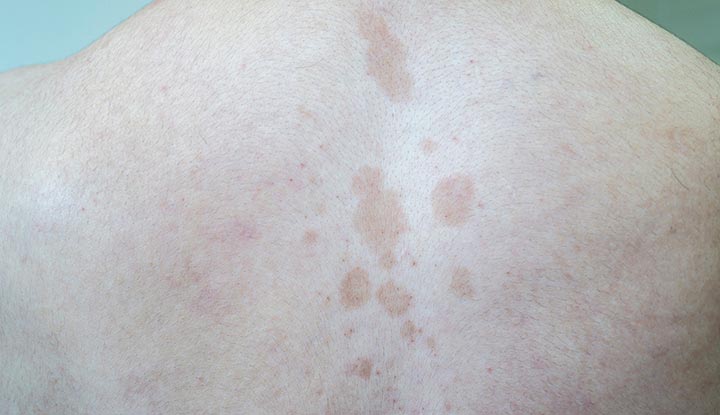Tinea versicolor is a fungal skin infection. It’s caused by an overgrowth of yeast on your skin. Tinea versicolor isn’t contagious, and most people recover fully after treatment. Tinea versicolor is also called pityriasis versicolor.
Advertisement
Cleveland Clinic is a non-profit academic medical center. Advertising on our site helps support our mission. We do not endorse non-Cleveland Clinic products or services. Policy

Tinea versicolor is a common fungal infection that causes discolored skin. People with tinea versicolor develop white, yellow, red, pink or brown spots. It’s caused by an overgrowth of a type of yeast (fungus) that’s naturally found on your skin. Hot weather, humidity and sun exposure can make tinea versicolor worse. It’s not harmful or contagious but can be mildly itchy. Tinea versicolor is most commonly found on your shoulders, back and upper chest.
Advertisement
Cleveland Clinic is a non-profit academic medical center. Advertising on our site helps support our mission. We do not endorse non-Cleveland Clinic products or services. Policy
Healthcare providers treat the condition with topical or oral antifungal medications. Some treatments are available over-the-counter. With treatment, most people recover fully from tinea versicolor. Tinea versicolor is also known as pityriasis versicolor.
Tinea versicolor can affect all skin colors differently. The overgrowth of fungus causes small, round patches of skin to get either lighter or darker than the surrounding skin. It’s more common for your skin to get lighter. The spots can appear white, pink, red, brown, light tan or yellow. On darker skin, tinea versicolor appears white or light tan. On lighter or paler skin, tinea versicolor looks light red or pink.
Some patches or spots can become scaly and dry. Over time, the patches get larger and start to connect, covering larger areas of your skin.
The patches might be more noticeable after sun exposure because the rest of your skin tans (or gets darker) but the infected area won’t. This makes them stand out a little more.
Tinea versicolor affects many people worldwide. It’s unclear why yeast overgrows on some people’s skin and not others. People living in tropical or subtropical regions are most at risk for tinea versicolor. It’s common during the summer months in temperate climates and around puberty when your skin’s oil glands are more active.
Advertisement
You may be at higher risk if you have a weak immune system. This may happen if you take medications like corticosteroids or have medical conditions like diabetes. Women who are pregnant are more susceptible to tinea versicolor because of hormonal changes.
Tinea versicolor isn’t contagious.
Tinea versicolor is common. It affects about 1% of people who live in mild or moderate climates. It affects up to 40% of people who live in tropical, humid climates.

For most people, tinea versicolor causes mild symptoms. These may include:
An overgrowth of yeast on your skin’s surface causes tinea versicolor. This yeast thrives in warm, moist and oily environments, causing it to grow out of control in small colonies. These yeast colonies cause the symptoms of tinea versicolor.
Some things that can trigger the yeast to grow out of control are:
Healthcare providers can diagnose tinea versicolor with simple skin tests. In one type of test, your healthcare provider scrapes off loose skin cells they believe are infected with tinea versicolor. This skin sample is examined under a microscope for yeast cells.
Your healthcare provider may also examine your skin using a Wood lamp. This device uses ultraviolet (UV) light to illuminate your skin. Areas of skin where tinea versicolor is present look yellow-green under the UV light.
Tinea versicolor can be a nuisance, but it’s generally easy to treat. Tinea versicolor is treated with topical creams, lotions or shampoos applied to the skin. For more severe or widespread cases of tinea versicolor, your healthcare provider may prescribe oral medications. These medicines all contain antifungals to kill the fungus or stop its growth. Proper treatment with antifungal medication is necessary to ensure a complete recovery and prevent recurrences.
Mild cases of tinea versicolor respond well to antifungal creams, lotions or shampoos you can purchase at the drugstore. You’ll apply these to your skin from anywhere to a few minutes to several hours before rinsing it off.
Advertisement
You’ll apply this as a cream or wash to areas of your skin affected by the condition. Your doctor may recommend a topical antifungal medication such as:
If your symptoms are severe, your healthcare provider may also prescribe oral antifungals such as:
There are several options for treating tinea versicolor yourself. The most common (and economical) is using a dandruff shampoo containing selenium. Apply the shampoo to your skin in the shower and let it sit for several minutes before rinsing. There are also several options available over-the-counter. Use these medications as directed. Contact your healthcare provider if you don’t notice changes after several weeks. A stronger medication may be needed.
Healthcare providers don’t recommend most natural or at-home remedies because their effects aren’t well studied.
Tinea versicolor doesn’t typically cause any serious side effects. If left untreated, you may experience worsening symptoms like increased discoloration or itching.
Tinea versicolor is generally easy to treat. Your skin may stay lighter or darker for several weeks or months, but it should return to its usual color eventually. Mild cases of tinea versicolor respond well to over-the-counter treatments, but some people need stronger medication from their healthcare provider. Tinea versicolor can return, especially in the summer months. Some people may need to use medication several times a year to manage skin discoloration.
Advertisement
Tinea versicolor isn’t a harmful infection and only affects the top layer of your skin. People often have more than one episode of tinea versicolor. Because the yeast grows naturally on your skin, it can recur (come back). Using medicated soap a couple of times each week or month can reduce recurrences of tinea versicolor.
For some people, tinea versicolor causes skin discoloration that lasts for months to years. In most cases, this discoloration fades away gradually after treatment is complete. Tinea versicolor doesn’t cause any long-term complications or disorders.
The yeast that causes this infection occurs naturally on your skin. Healthcare providers aren’t sure why some people develop tinea versicolor and others don’t.
If you have a history of tinea versicolor, your healthcare provider may recommend you use soap containing zinc pyrithione (like Vanicream™ Z-Bar or DermaZinc™ Zinc Therapy Soap), ketoconazole (Nizoral®) or selenium sulfide (Selsun Blue®). This type of soap may help prevent future infections and yeast overgrowth. Your healthcare provider may also recommend using prescriptions medications during summer months when tinea versicolor is more likely to return.
Some other things you can do to lower your risk for repeat tinea versicolor infections are:
Advertisement
You may be at higher risk for tinea versicolor if you live in a hot, tropical climate or if you’re a young adult. This is because younger adults have changing hormones and increased oil production, both of which can contribute to tinea versicolor.
You can treat tinea versicolor with antifungal medicine from the drug or grocery store. This can clear up mild cases of tinea versicolor within a few weeks. Topical antifungal creams, shampoos or lotions work best when they soak into your skin for several minutes a day.
Contact your healthcare provider if you don’t see improvement after two to three weeks of daily use. They may want to prescribe a more effective medication.
It’s normal to have questions for your healthcare provider. Some common questions to ask about tinea versicolor include:
Yes, tinea versicolor is more common during pregnancy due to hormonal changes and a weakened immune system.
Vitiligo is a skin condition that causes light spots on your skin. It’s often mistaken for tinea versicolor. There are some differences between the two conditions. The spots caused by vitiligo are smooth, while tinea versicolor spots can have a scaly texture. Vitiligo also tends to affect different areas from tinea versicolor. It’s likely to appear on your face, eyes, mouth, fingers and hands. An autoimmune condition causes vitiligo, but a fungal infection causes tinea versicolor.
Tinea versicolor can be a nuisance and make you feel insecure. Luckily, the discoloration it creates on your skin is highly treatable with over-the-counter antifungal creams or shampoos. Using them daily for several weeks can help you manage the infection. Your healthcare provider can also prescribe stronger antifungal medications for more severe tinea versicolor or recurring infections. Talk to your healthcare provider about any questions you have about tinea versicolor. They’re there to help you and get you feeling more confident in your skin again.
Every day, people see your skin, hair and nails. At Cleveland Clinic, our expert and caring dermatology team will make sure they’re healthy and strong.

Last reviewed on 04/13/2022.
Learn more about the Health Library and our editorial process.